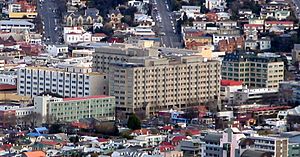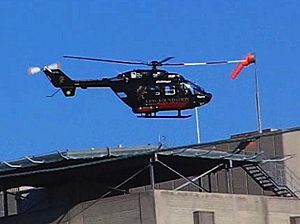Dunedin Hospital facts for kids
Quick facts for kids Dunedin Hospital |
|
|---|---|
| Southern District Health Board | |

Dunedin Hospital from Signal Hill
|
|
| Geography | |
| Location | Dunedin, New Zealand, Otago, New Zealand |
| Coordinates | 45°52′10″S 170°30′31″E / 45.8694°S 170.5086°E |
| Organisation | |
| Care system | Public |
| Hospital type | Teaching, District General |
| Affiliated university | University of Otago |
| Services | |
| Emergency department | Yes |
| Helipad | (ICAO: NZDH) |
| Beds | 398 (as of 2023) |
| History | |
| Founded | 1851 |
Dunedin Hospital is a big public hospital in Dunedin, New Zealand. It helps people from the Otago and Southland regions. This area covers about 300 kilometers and has around 330,000 people.
Contents
How Dunedin Hospital Works
Dunedin Hospital is the largest hospital in New Zealand south of Christchurch. It is a special hospital that takes care of serious cases. Patients often come here from smaller hospitals in Otago and Southland. These include hospitals in Clyde, Queenstown, Oamaru, Gore, and Invercargill. Dunedin Hospital is also the main place for treating serious injuries in the Otago and Southland areas.
The Southern District Health Board runs Dunedin Hospital. It is in the center of Dunedin, very close to the University of Otago. The hospital takes up a whole city block. It has about 400 beds and works closely with the University of Otago. Around 3,000 people work at the hospital.
Queen Mary Maternity Centre
Dunedin Hospital has a special part called the Queen Mary Maternity Centre. This is where babies are born. It replaced an older hospital called Queen Mary Hospital, which opened in 1937.
Hospital Helipad
The main building of the hospital has a helipad on its roof. This helipad was built around the year 2000 after people raised a lot of money. Having a helipad on the roof means that helicopters can land right at the hospital. This helps patients get care faster, as they do not need to be moved by ambulance from another landing spot. Only certain types of helicopters can land on the roof for safety reasons.
History of Dunedin Hospital
The first hospital in Dunedin was built in 1851 at The Octagon. It moved to where the current hospital is now in 1865.
Over time, the old buildings were replaced, and new ones were added. Many of these buildings were taken down in the 1970s. A new main ward and office building opened in 1980.
Health Outbreaks
In March 2007, some parts of the hospital had to close because of a suspected outbreak of norovirus. This virus was thought to have been brought in by a patient. In August 2008, the hospital was put on lockdown for a week due to another norovirus outbreak. This affected many patients and staff. Most visitors were not allowed, and many medical procedures were postponed.
In June 2022, Dunedin Hospital was closed to visitors because of a COVID-19 outbreak in its wards.
Rebuilding the Hospital
Parts of the hospital are quite old. For example, the Clinical Services Block, built in 1965, used asbestos, which was common back then. This building also had problems like roof leaks, which let rain into the operating rooms during storms. Because of these issues, a big project to rebuild the entire hospital has been underway.
In May 2018, the Government announced that a new public hospital would be built. It was planned for the site of the old Cadbury factory and a nearby block. The project was estimated to cost NZ$1.4 billion and was expected to finish by 2026. The Government bought the old Cadbury factory site.
In September 2022, there were reports that the Ministry of Health was thinking about making the new hospital smaller. This was due to rising costs. The budget had increased from NZ$1.2 billion to NZ$1.47 billion. In December 2022, it was confirmed that the number of beds would be reduced from 421 to 398. The number of operating theaters would also be reduced from 28 to 26. Some medical equipment would also be delayed.
The Mayor of Dunedin, Jules Radich, first supported these changes. However, he changed his mind after many people in Dunedin disagreed. In January 2023, it was reported that a building for staff workspaces was removed from the plans. More than 450 non-clinical spaces were also cut. Health Minister Little said the new hospital would still be bigger than the old one. The New Zealand Nurses Organisation started a petition against the cuts.
In January 2023, the Dunedin City Council voted to fight the changes to the hospital's design. In February, the new Health Minister, Ayesha Verrall, met with the councillors to discuss their concerns.
In April 2023, Minister Verrall announced that the Government had put NZ$10 million back into the hospital budget. This meant a scanner and a collaborative space for doctors would be returned. The Government also gave NZ$97 million for the hospital's digital systems. However, Verrall said no more big changes would be made to the revised plans. Construction of the new hospital had begun.
In June 2023, plans for a special learning center for students at the new hospital were stopped due to high costs.
During the 2023 New Zealand general election, the National Party said they would put back some of the things that were cut from the Dunedin Hospital if they won. In July 2023, they promised to invest NZ$30 million to restore cut beds, theaters, and a PET scanner. In September 2023, the Labour Government announced it would reverse two proposed cuts: a separate pathology laboratory and 24 beds for elderly mental health patients.
In January 2024, Health Minister Shane Reti said the new government was committed to the hospital. In May 2024, reports showed that construction costs had gone over NZ$2 billion. There was also a six-month delay for the main building. In June 2024, Reti repeated that the government was open to keeping its promise to restore the cut beds and equipment.
In August 2024, Health New Zealand was planning smaller hospital builds elsewhere to avoid delays and cost increases like those seen in Dunedin. In September 2024, there were reports that the Government was thinking about cutting emergency beds and downgrading operating theaters to save money. Many people, including Mayor Radich, were upset by these ideas. On September 6, Radich and the Dunedin City Council asked for the hospital rebuild to continue without clinical cuts.
On September 17, 2024, Mayor Radich and a Nurses' Organisation representative met with Health Minister Reti. They presented a petition with 23,000 signatures against the proposed cuts. On September 19, the Dunedin City Council started a campaign called "Hospital Cuts Hurt." This included a protest march on September 28.
On September 26, 2024, Ministers Reti and Chris Bishop announced that the Dunedin Hospital rebuild would be made much smaller. They said the current plans could not be built within the NZ$1.88 billion budget. Bishop worried the cost could go up to NZ$3 billion. They were looking at two options: making the project smaller within the current design, or rebuilding the hospital in stages.
Mayor Radich called these proposals "unacceptable." On September 28, 2024, 35,000 people protested in Dunedin's Octagon. They demanded that the Government keep its promise to rebuild the hospital without cuts.
In October 2024, the Mayor of Invercargill, Nobby Clark, and other councillors supported the campaign against the cuts. They said the hospital was very important for people in Otago and Southland. On October 16, 44 clinical directors from the southern region warned that the proposed cuts would affect the hospital's ability to provide good care and training.
On November 5, 2024, a petition with 34,000 signatures was delivered to Parliament by the mayors of Dunedin, Waitaki, and Invercargill. They used a special ambulance called Cliff.
On January 31, 2025, Health Minister Simeon Brown announced that a new inpatient building would be built at the old Cadbury factory site for NZ$1.9 billion. He said the new hospital would have 351 beds, fewer than the old hospital's 396 beds. It would also have 20 short-stay surgical beds, 24 theaters, 58 emergency department spaces, and 20 imaging units. Mayor Radich welcomed this news, saying the right structure was being built.
In April 2025, Health New Zealand confirmed that the number of ICU beds would be 20 at first, with room to increase to 40 later. In May 2025, reports showed plans to reduce mental health beds for elderly people from 24 to eight. Overall, the rebuilt hospital was planned to open with 371 beds instead of 430, with the possibility to increase to 424 beds over time.
On July 3, 2025, Health Minister Brown shared a timeline for the hospital's construction. The first phase of building was expected to start in July 2026. The second phase, involving earthquake-resistant foundations, was expected to begin in January 2026. The third phase, installing base isolators, was expected to start in July 2026. Steel structure construction was expected to begin in August 2026. The NZ$1.88 billion hospital, with 351 beds, is expected to open in 2031.
People Connected to Dunedin Hospital
- Colin Bouwer (born 1950) – a former head of psychiatry.
- Hardwicke Knight (1911–2008) – a director of the medical photography unit and historian.
- Jim Mann (born 1944) – an expert in hormones and glands.
- Edward Hulme (1812–1875) – an administrator.
- Edith Statham (1853–1951) – a nurse.
- Jessie Torrance (1874–1949) – a nurse and church worker.



